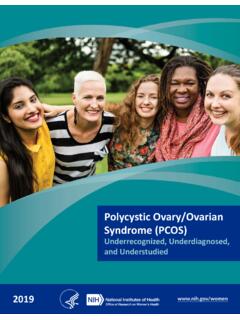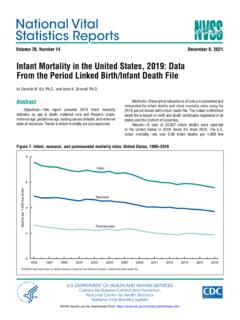Transcription of Maternal Morbidity and Mortality
1 Maternal Morbidity ANDMORTALITYWhat Do We Know? How Are We Addressing It? Understanding Maternal Morbidity and Mortality (MMM) in the Context of the Health of Women Maternal HEALTH covers the health of women during the preconception, pregnancy, and postpartum periods. A series of important events and changes physical, emotional, and social occur before, during, and well after the 40 weeks of gestation and the first year after childbirth. These changes are natural but can be stressful, and they have health consequences across a woman s life Department of Health and Human Services (HHS) defines women s health as diseases and conditions .. experienced by women across the lifespan and in the social context of their lives. HHS sees pregnancy as an important part of the overall health of women. The National Institutes of Health (NIH), which is the Nation s foremost medical research agency, encourages scientists to study pregnancy as part of the life World Health Organization (WHO) defines Maternal Morbidity as any health condition attributed to and/or aggravated by pregnancy and childbirth that has a negative impact on the woman s wellbeing.
2 1 The Centers for Disease Control and Prevention (CDC) states: Severe Maternal Morbidity (SMM) includes unexpected outcomes of labor and delivery that result in significant short- or long-term consequences to a woman s health. 2 Severe Maternal Morbidity (SMM): What Are the Trends?SMM affected more than 50,000 women in the United States in rates of SMM have nearly doubled during the past need for blood transfusions is the most common indicator of every pregnancy-related death in the United States, 70 women experience a near miss (SMM).2 SMM in the United States, 1993-2014 Rate of Maternal Morbidity per 10,000 delivery hospitalizationsSource: CDC, 20172 Who Is Most Affected by SMM?More likely to occur for women who are: Age 20 or younger Age 40 or older Receiving Medicaid Residents of a low-income ZIP : Fingar et al.
3 , 20183 More likely to occur at hospitals located in:Source: Fingar et al., 20183 From 2012 2015, compared with White women, the incidence of SMM was: 166% higher for Black women 122% higher for Hispanic women 117% higher for Asian/Pacific Islander women 148% higher for American Indian/Alaska Native women Source: Admon et al., 201843 According to WHO: Maternal death is the death of a woman while pregnant or within 42 days of termination of pregnancy, irrespective of the duration and site of the pregnancy, from any cause related to or aggravated by the pregnancy or its management but not from accidental or incidental causes. 5 The CDC uses the term pregnancy-related death and defines it as the death of a woman while pregnant or within 1 year of the end of a pregnancy regardless of the outcome, duration, or site of the pregnancy from any cause related to or aggravated by the pregnancy or its management, but not from accidental or incidental causes.
4 6 Maternal Mortality : What Are the Trends?Each year, about 700 women die in the United States as a result of pregnancy or delivery Experts estimate that approximately 50% of Maternal deaths are States Has Highest Maternal Mortality Among High-Income Countries9 Source: GBD 20159 Credit: Rob the Maternal Mortality rate increased by , global Maternal Mortality rates decreased during the same period (1990 2015).10 Maternal Mortality : Who Is Most Affected?Pregnancy-related Mortality Ratios, 2011 2014 (deaths per 100,000 live births)Source: CDC, 20186In 2015, in-hospital Mortality for deliveries was three times higher for Blacks than for such as education and higher socioeconomic status do not mitigate the elevated risks of SMM and Maternal Mortality among Black women living in the United States, of pregnancy-related deaths from 2011 2013 occurred in women born in another 2011 2013, 30% of pregnancy-related deaths occurred in women 35 years of age or Factors Influence MMM?
5 Preconception HealthPreconception health is the health of women prior to becoming pregnant during their reproductive Factors , hypertension, and current cigarette smokingHealth-Promoting Factors weight and recommended physical activityGenerally, risk factors are highest and health-promoting factors lowest for: women ages 35 44, Black women, women without insurance, and those residing in Southern 2008 2012, 43% of women delivering in a hospital had risk factors for SMM a preexisting chronic disease, a pregnancy-associated disease, or advanced Maternal age. This represents a increase since 1993 19972008 2012 Behavioral Risk FactorsSmokingSmoking during pregnancy increases the risk of complications, such as placenta previa, placental abruption, and premature rupture of the pregnant women between 2010 and 2013.
6 About 16% used tobacco during the past month About 11% had tobacco dependence during the past month16 Overweight and ObesityAmong pregnancy-related deaths from 2011 2013, occurred among women who were obese before 2014, about half of women were overweight or obese before they became UseBetween 2004 2005 and 2014 2015, opioid-related deliveries increased from to per 1,000 delivery (4%)2016 (10%)250%The percentage of pregnancy-associated deaths involving opioids more than doubled between 2007 and increase in pregnancy-associated deaths involving opioids was more prominent among White 2016, 78% of pregnancy-associated deaths involving opioids were due to heroin or synthetic opioids ( , fentanyl) an increase of 17% since CarePoor prenatal care utilization late onset of care, fewer visits, or both significantly increases the risks of insufficient gestational weight gain, prenatal smoking, premature rupture of membranes, precipitous labor, no breastfeeding, Maternal postnatal underweight, and postpartum 2016, 15% of women received inadequate prenatal women, women with less education, women having a fourth or higher-order birth, and non-Hispanic Native Hawaiian and other Pacific Islander women were least likely to begin care in the first trimester of pregnancy and have at least adequate prenatal women who had pregnancy-related deaths and whose prenatal care status was known, had not received any prenatal care and started prenatal care in their second or third Maternal Morbidity .
7 Short-term RisksSMM is stressful and affects the woman, her family and friends, and the overall community. For example, women who experience SMM may be at increased risk of post-traumatic stress disorder symptoms during the 6 8 weeks after studies suggest that1. Subsequent hospitalizations during the year after delivery may be higher for women who experience SMM, even when those with preexisting chronic conditions are excluded,232. Women with SMM may have an increased likelihood for emergency department visits 90 days after delivery,24 and3. Women with hypertensive disorders of pregnancy (HDP) had higher hospitalization readmission rates for cardiovascular disease, with Black women having a higher rate than White and Hispanic average hospital cost of a delivery without SMM was $4,300, compared with $11,000 for a delivery with any SMM, from 2011 to and Intervention StrategiesImpact on Risk for Disease in Later LifeTroglitazone41 Reduced incidence of T2DM by 50% in Hispanic women with previous rate of per year during treatment with pioglitazone for 3 years, compared with a rate of per year during placebo lifestyle changes43 Reduced progression to T2DM by 35% compared with progression to T2DM by 40% compared with for preeclampsia with blood pressure measurements throughout pregnancy is recommended ( Preventive Services Task Force, B recommendation).
8 44 Regularly taking aspirin45 Eliminates increased risk ( times increased likelihood) of CVA among women age <60 years with any prior hypertensive disorders of interventions (exercise, diet, and smoking cessation)46 Decreases cardiovascular risk by about 10% among women with a preeclampsia delivery Cesarean delivery was associated with about a 50% lower risk of stress urinary incontinence and overactive bladder and a 70% lower risk of POP compared with spontaneous vaginal is is needed on specific interventions to prevent depression among women who have experienced postpartum depression. How Does Maternal Health Affect Women Across the Life Course? Condition During PregnancyRisk for Disease in Later LifeGestational diabetes mellitus (GDM):Prevalence is estimated at in the United risk of type 2 diabetes mellitus (T2DM):Among women with GDM, developed a glucose metabolism disorder 10 to 14 years postpartum, compared with of those without GDM a more than threefold increased :About 5% of all hospital deliveries involved preeclampsia/eclampsia in Increased risk of hypertension (HTN), cardiovascular disease (CVD), or cardiovascular accident (CVA).
9 Women with early-onset (<34 weeks) hypertensive disorders of pregnancy have more than twice the risk of developing incident CVD and more than a fourfold risk of developing incident increases the risk of incident heart failure in later life doubles the risk of coronary heart disease, stroke, and death because of coronary heart disease or vaginal delivery:The vast majority of hospital stays for vaginal delivery ( ) involved at least one complicating condition in vaginal delivery numbered per 1,000 laceration (any degree of tear of the tissues that separate the vagina from the anus) numbered per 1,000 risk of pelvic floor disorders: five to ten years after a first delivery: Forceps delivery increased the odds of pelvic floor disorders , almost a threefold risk for overactive bladder and nearly double the risk for pelvic organ prolapse (POP).
10 33 A history of spontaneous perineal laceration more than doubled the risk for Operative vaginal delivery increased the risk for POP more than Operative vaginal delivery was associated with almost double the risk of anal incontinence and POP compared with spontaneous vaginal : of women in the first trimester, of women in the third trimester, and of postpartum women (3 5 months) experienced serious psychological distress (SPD)* during the past overall prevalence of postpartum depressive symptoms was for women in 27 states in women ages 14 49 who were hospitalized for delivery from 2004 to 2013, had a diagnosis of depression and/or risk of depression and anxiety: Servicewomen who were first-time mothers and experienced postpartum depression from 1998 to 2010 were more than seven times more likely to experience depressive disorders, more than three times more likely to experience anxiety disorders, and more than four times more likely to experience bipolar disorders subsequently compared with women without postpartum whose postpartum depression persisted for 8 months showed elevated depressive symptoms up to 11 years after childbirth, according to a study of *SPD was assessed with questions about how nervous, hopeless, restless or fidgety, sad or depressed, or worthless the respondent felt and to what extent everything felt like an During PregnancyRisk for Disease in Later LifeGestational diabetes mellitus (GDM).







